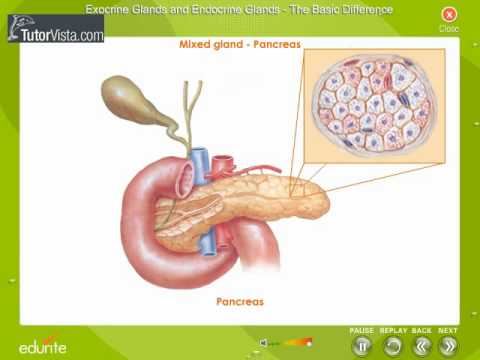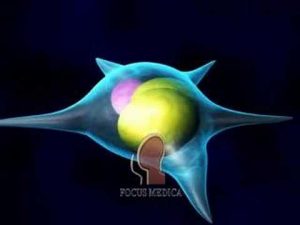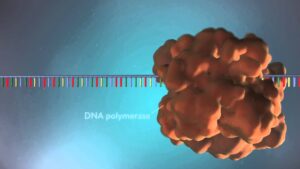Follow us at: https://plus.google.com/+tutorvista/ Check us out at http://www.tutorvista.com/content/biology/biology-iv/chemical-coordination-animals/endocrine-glands.php Exocrine Glands Exocrine glands are glands that secrete their products (excluding hormones and other chemical messengers) into ducts (duct glands) which lead directly into the external environment. They are the counterparts to endocrine glands, which secrete their products (hormones) directly into the bloodstream (ductless glands) or release hormones (paracrines) that affect only target cells nearby the release site. Exocrine glands contain a glandular portion and a duct portion, the structures of which can be used to classify the gland. •The duct portion may be branched (called compound) or unbranched (called simple). •The glandular portion may be tubular, acinar, or may be a mix of the two (called tubuloacinar). If the glandular portion branches, then the gland is called a branched gland. Endocrine glands are glands of the endocrine system that secrete their products, hormones, directly into the blood rather than through a duct. The main endocrine glands include the pituitary gland, pancreas, ovaries, testes, thyroid gland, and adrenal glands. The hypothalamus is a neuroendocrine organ. Other organs which are not so well known for their endocrine activity include the stomach, which produces such hormones as ghrelin. Local chemical messengers, not generally considered part of the endocrine system, include autocrines, which act on the cells that secrete them, and paracrines, which act on a different cell type near by. Please like our facebook page http://www.facebook.com/tutorvista

Exocrine Gland and Endocrine Glands
- Post author:
- Post published:May 2, 2021
- Post category:Uncategorized
- Post comments:0 Comments
You Might Also Like

TPO antibodies in hypothyroidism

Overweight & Obesity Video – 2

Intermittent Fasting & Fasting Video – 29

Do You Need More Protein Than You Think You Do?

Components OF Skill Related Fitness

How To Do a Close Grip Tricep Bench Press

Reversing Diabetes with Food

Meditation Video – 1

Hematology Video – 3

Military Psychiatry Video – 2

What is TB? | Infectious diseases | NCLEX-RN | Khan Academy

Chocolate Nutrition Video – 1

Body Composition

Clinical Neurophysiology Video – 1

Oncology Video – 2

2 NO CHEAT Side Lateral Raise Variations You Should Use On Shoulder Day
One Arm Row Dumbbell-10

Special Weight Loss Routine Video – 5

BODYBUILDING MOTIVATION ~ This will Destroy you

Geriatric Physiotherapy Video – 2

20 Types of Push Up

Arthritis Nutritional Tips

ICD-10 for BMI — Body Mass Index ICD-10-CM Coding

Rugby Video – 2

Revital Multivitamins | क्या ये असरदार है ? जानिये सबकुछ | Revital usage, benefits & side effects

Insulin Resistance

How to drain a subungual hematoma (blood blister beneath the toenail)

Geriatric Psychiatry Video – 2

Pre and Post Workout shakes preparation by Joseph Ferandez IFBB Pro

LEG PRESS की 5 गलतियां तुरंत रोकें- 5 MISTAKES STOP NOW!!

Cardio-Thoracic Physiotherapy Video – 2

What is the normal range of T3, T4 and TSH? – Dr. Mahesh DM

(CC) How to Pronounce ondansetron (Zofran) Backbuilding Pharmacology

DNA replication – 3D

Bodyweight Workout For More Strength and Muscle

Muscular Strength Asanas Video – 4

How To Lose Weight: Phentermine

Top 7 Muscle Groups Women Love in Men. Build Muscle Faster DEMO.

Barbell Deadlift Bent Row Complex | Exercise Guide

Massage Video – 2

Top 3 Triceps Exercises with 1 Dumbbell! (Subscribers Request)

